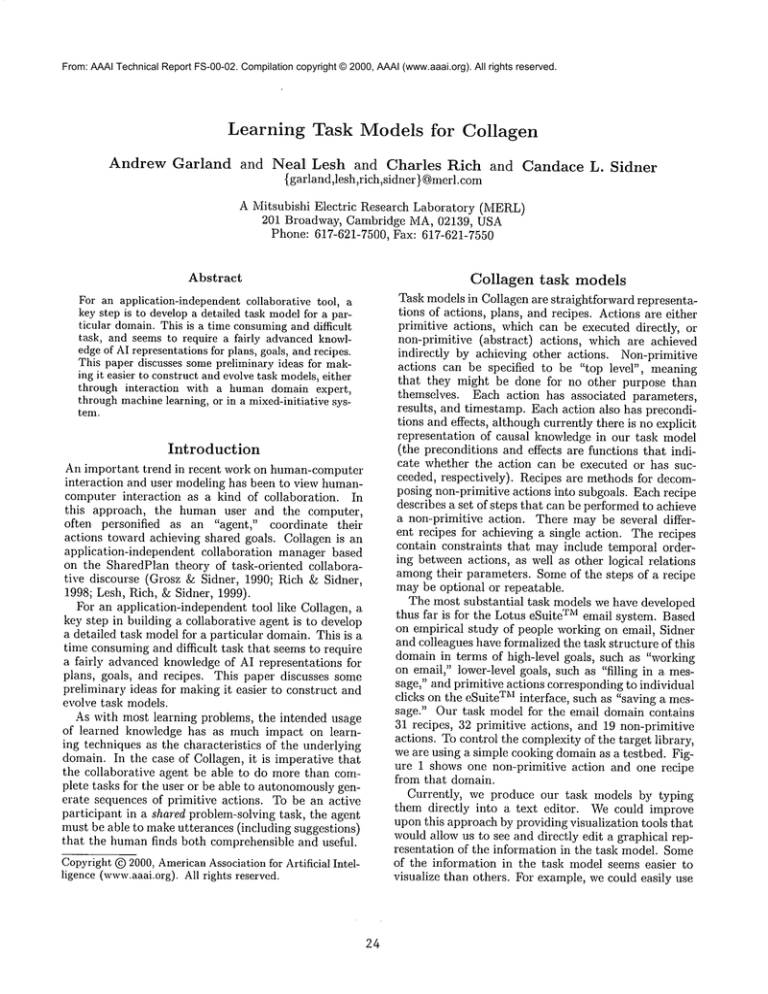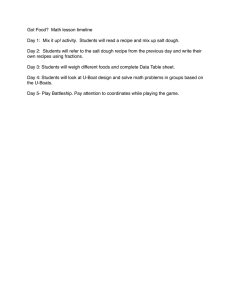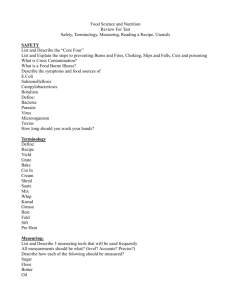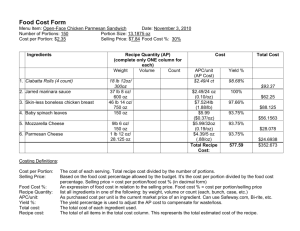
From: AAAI Technical Report FS-00-02. Compilation copyright © 2000, AAAI (www.aaai.org). All rights reserved.
Learning Task Models for Collagen
Andrew
Garland
and
Neal Lesh and Charles
Rich and
{garland,lesh,rich,sidner } @merl.com
Candace
L.
Sidner
A Mitsubishi Electric Research Laboratory (MERL)
201 Broadway, Cambridge MA, 02139, USA
Phone: 617-621-7500, Fax: 617-621-7550
Abstract
For an application-independent collaborative tool, a
key step is to develop a detailed task modelfor a particular domain.This is a time consumingand difficult
task, and seems to require a fairly advanced knowledgeof AI representations for plans, goals, and recipes.
This paper discusses somepreliminary ideas for making it easier to construct and evolve task models,either
through interaction with a human domain expert,
through machinelearning, or in a mixed-initiative system.
Introduction
An important trend in recent work on human-computer
interaction and user modeling has been to view humancomputer interaction as a kind of collaboration. In
this approach, the human user and the computer,
often personified as an "agent," coordinate their
actions toward achieving shared goals. Collagen is an
application-independent
collaboration manager based
on the SharedPlan theory of task-oriented collaborative discourse (Grosz &: Sidner, 1990; Rich &: Sidner,
1998; Lesh, Rich, &Sidner, 1999).
For an application-independent tool like Collagen, a
key step in building a collaborative agent is to develop
a detailed task modelfor a particular domain. This is a
time consumingand difficult task that seems to require
a fairly advanced knowledge of AI representations for
plans, goals, and recipes. This paper discusses some
preliminary ideas for makingit easier to construct and
evolve task models.
As with most learning problems, the intended usage
of learned knowledge has as much impact on learning techniques as the characteristics of the underlying
domain. In the case of Collagen, it is imperative that
the collaborative agent be able to do more than complete tasks for the user or be able to autonomouslygenerate sequences of primitive actions. To be an active
participant in a shared problem-solving task, the agent
must be able to make utterances (including suggestions)
that the humanfinds both comprehensible and useful.
Copyright(~) 2000, American
Associationfor Artificial Intelligence (www.aaai.org).All rights reserved.
24
Collagen
task models
Task models in Collagen are straightforward representations of actions, plans, and recipes. Actions are either
primitive actions, which can be executed directly, or
non-primitive (abstract) actions, which are achieved
indirectly by achieving other actions. Non-primitive
actions can be specified to be "top level", meaning
that they might be done for no other purpose than
themselves. Each action has associated parameters,
results, and timestamp. Each action also has preconditions and effects, although currently there is no explicit
representation of causal knowledge in our task model
(the preconditions and effects are functions that indicate whether the action can be executed or has succeeded, respectively). Recipes are methods for decomposing non-primitive actions into subgoals. Each recipe
describes a set of steps that can be performed to achieve
a non-primitive action. There may be several different recipes for achieving a single action. The recipes
contain constraints that may include temporal ordering between actions, as well as other logical relations
amongtheir parameters. Someof the steps of a recipe
may be optional or repeatable.
The most substantial task models we hax,e developed
thus far is for the Lotus eSuite TM email system. Based
on empirical study of people working on email, Sidner
and colleagues have formalized the task structure of this
domain in terms of high-level goals, such as "working
on email," lower-level goals, such as "filling in a. message," and primitive actions corresponding to individual
clicks on the eSuite TM interface, such as "saving a message." Our task model for the email domain contains
31 recipes, 32 primitive actions, and 19 non-primitive
actions. To control the complexity of the target library,
we are using a simple cooking domainas a testbed. Figure 1 shows one non-primitive action and one recipe
from that domain.
Currently, we produce our task models by typing
them directly into a text editor. Wecould improve
upon this approach by providing visualization tools that
would allow us to see and directly edit a graphical representation of the information in the task model. Some
of the information in the task model seems easier to
visualize than others. For example, we could easily use
public act Boil {
parameterLiquid liquid;
}
public recipe ARecipeNameachievesPreparePasta{
step Boil boilWater;
optionalstep GetPastagetPastaIfNeeded;
step MakePastamakeSomePasta;
bindings{
achieves.pastaWater
== boilWater.liquid;
}
constraints{
getPastaIfNeeded.item
== makeSomePasta.pasta;
boilWater.liquid
== makeSomePasta.water;
boilWaterprecedesmakeSomePasta;
getPastaIfNeeded
precedesmakeSomePasta;
}
Figure 1: Sample Collagen representations
an "and/or" graph to represent subgoal relationships
and directed arrows (of a particular color) to represent ordering relationships between actions in a recipe.
However,it seems more difficult to visualize arbitrary
constraints on parameters of an action. It seems that
creating such tools for Collagen’s task models would
be a relatively straightforward, though not small, engineering task.
There are two basic ways in which we envisage task
models for Collagen being acquired:
1. Programming-By-Demonstration.
The development
of visualization tools will support the construction
and maintenance of task models by domain experts
who are not experienced in AI or task modeling.
However, programming-by-demonstration techniques
are an appealing alternative
to asking a domain
expert to use visualization tools alone. The appeal
lies in the expectation that domainexperts will find
it easier to perform tasks (and then discuss the performance) than to construct an abstract task model
from scratch.
Weimagine that the humanexpert will perform simple tasks on the application to be modeled. The
performed tasks might be the same ones that one
would use to demonstrate the application to another
human. Afterwards, the expert will annotate a log
of her actions so that the computer can extract a
task model fl’om the annotated logs. The actions in
the log could be annotated, for example, to indicate
whether an action was optional or repeatable.
Furthermore, the expert would segment, or hierarchically cluster, the action log such that actions that
contribute to a single purpose will be put in the same
segment. Each segment would correspond, roughly,
to a single recipe in the task model. (Although there
may be several demonstrations of each recipe.)
Figure 2 is an example of a possible segmentation and
for a simple cooking domain.
annotation for the actions that someonemight use to
demonstrate how to use a web site for finding movies
playing in local theaters. The actions are labeled A1
through A6, the indentation indicates the segmentation, and the segment labels and the annotations are
in square brackets.
.
25
Machine learning. As described in the next section, there are many pieces of information needed in
order to develop a task model that takes full advantage of the expressiveness of the Collagen representation. While pro~amming-by-demonstration techniques will hopefully make the knowledge elicitation
task seem more natural to a domain expert, they
will not reduce the number of annotations needed.
Machine learning techniques provide a means of
reducing the annotation effort of a domain expert by
inferring pieces of information instead of requiring
the expert to explicitly specify them.
This paper is concerned with two possible automated approaches to learning pieces of information
helpful in developing task models. One approach
is to incrementally construct a more accurate task
model from a series of examples. In essence, general
knowledgeabout the relationships that exist between
actions and recipes can be exploited to allow a learning engine to infer annotations a domain expert
may have made. Another approach is statistical
in
nature. We imagine that the computer might have
access to a (potentially very large) log of unannotated user activity of the application. These logs
could be analyzed by statistical inference techniques
to detect relationships that are important to constructing a task model, such as segments of related
actions or optional recipe steps. The last section
of this paper discusses how these machine learning
techniques and programming-by-demonstration techniques can be combinedin a mixed-initiative learning
[Segment:GET-MOVIE-SCHEDULE]
(AI) Go to MovieFindersite
[Segment:SELECT-MOVIE]
(A2) Fill in directorslot with Woody Allen
(A3) Press GO button
(A4) Select "Sweetand Low Down"
[Segment:SELECT-THEATER]
(A5) Select"KendallTheater"
(A6) Print page [optional]
Figure 2: Sample segmentation and annotation.
system.
for segmentations.
Learning
issues
The previous section presented an overview of the
knowledge contained in a Collagen task model. This
section discusses in detail the pieces of information
needed to construct a task model that takes full advantage of the expressiveness of the Collagen representation. For each piece of information, the tradeoffs between explicitly eliciting that information from
a domain expert (through annotations)
and using
machine learning techniques are discussed.
The first three pieces of information outlined -- segmentations, action names, and recipe names -- can be
considered the bare minimumamount of information
needed to develop a Collagen task model. They are
essential in order to support an agent capable of making
utterances (including suggestions) that a humanfinds
useful for two reasons. First, the names given to nonprimitives (and the names of the recipes that achieve
them) will be an essential piece of the utterance, be it
text or voice, presented to the user by the collaborative agent in many conversations. Second, the agent
should make utterances at a time that seems "natural" to the user; in manycases, this entails top-down
problem-solving: hierarchically decomposing problems
into subproblems. Therefore, a linear representation for
a task model, even one containing generalized actions
(Bauer, 1998, 1999), is insufficient.
Segmentations
The decomposition
of an example
trace into segments of related actions is essential in
order to learn a task model containing hierarchical
problem-solving representations. Each segment corresponds to a non-primitive action. Also, the primitire actions and sub-segments of a segment comprise
the steps in a recipe to achieve that non-primitive
action.
Segmenting an execution trace would not necessarily
be difficult for the humandomain expert who generated a trace given the proper visualization tools. At a
conceptual level, identifying segments can be viewed
as a grammar induction problem (if one focuses on
just the primitive action types, i.e., ignores particular parameter values). Therefore, statistical inference
techniques will be able to generate compactrepresentations that we believe will be reasonable estimates
26
Non-primitive action names Each segment identifled, generally consisting of several actions and/or
segments, accomplishes a non-primitive action. It
is important that the purpose of each segment be
labeled consistently so that the learning engine can
determine whether two segments represent two different ways to achieve the same non-primitive action
or whether they represent the achievement of two
different non-primitive actions. Techniques to automatically generate segmentations could presumably
also generate consistent labelings to be used as surrogates for action names (albeit semantically meaningless ones).
Recipe names The particular
"steps" (i.e. set of
primitive actions and sub-segments) that make up
segment can be considered a recipe for achieving the
corresponding non-primitive action. If the segment
is annotated with a recipe name, the learning engine
can determine whether the seen segment requires generalizing the current model of that recipe developed
from previous examples. (This could entail, for example, marking a step that was believed to be required
as optional or by dropping previously believed constraints that are violated by the current example.)
A good heuristic for allowing a learning engine to consistently assign the same name to a given recipe is to
presume that recipes that accomplish a given purpose
are composedof unique, disjoint sets of required step
types. In that case, recipe names can be generated
such as
PreparePastaRecipeVia_Boil_MakePast
a
where step types are separated by an underscore and
types for optional steps (such as GetPasta) are omitted. Step types are sorted in the recipe name to
remove dependence on the order of seen steps. When
the optionality of steps is learned, rather than presented as an annotation, the presumption allows for
easily tracking and updating recipe names to reflect
changing beliefs about the optionality of steps. An
arbitrary number of steps of the same step type are
accommodatedby this heuristic.
Recipe step names Each recipe logically
decomposes into steps. However, in general, there is no
guarantee that a seen step of a given type (such as
clicking GO)in the given example instance refers to
a step of the same type in the developing model for
the recipe. For example, it could be the case that the
"true" recipe contains two steps of the given type,
both of which are optional. In order for the learning
engine to be able to makelogically correct deductions
about a step in a recipe, it needs a way to identify
the seen step with the step in the developing model.
Humandomain experts are unlikely to find assigning step names to individual steps palatable. A good
heuristic for allowing a learning engine to "guess" at
a step name is to presume that each recipe contains
only a single step of a given type and that if multiple steps have the same type, then the step must be
repeatable. In this case, a string representation of
the 1step type can be used as the step name.
Recipe step optionality
or repeatability
Marking steps as optional or repeatable
on a
consistent basis simplifies the reasoning needed by
a learning engine. Further, such boolean characteristics could be clearly presented and easily changed
(e.g., with mouse-event driven pull-down menu) in
good visualization tool.
Identifying optional steps can also be easily inferred
by a learning engine, given the heuristics already
mentioned for inferring recipe and step names. When
comparing the current example of a recipe to the
model of the recipe developed from previous examples, any steps in the model that are missing in the
example can be presumed to be optional as can any
steps in the example that are not part of the model.
For the inferences to be provably correct in the worst
case would require seeing O(n) examples of a recipe,
where n is the numberof instantiations of the recipe
that are possible (to assure that n is finite, we can
assume that repeatable steps are never repeated more
than a fixed constant N number of times). However,
the best case is O(1) and we can presume that since
the domain expert is interested in minimizing their
own work, we are more likely to be faced with the
best case rather than the worst.
Recipe constraints
Although Collagen supports
arbitrary structural relationships between parameters and results, recipes typically exploit two kinds
of constraints. The first is partial ordering information between steps and the other is equality of
action parameters and results. Annotating examples
to denote these relationships will vary greatly in
difficulty depending on the visualization tool, the
amount of relationships that exist in a domain, and
the level of comfort the domain expert has with
thinking about such relationships.
1If the temporal ordering of the steps can be guaranteed
to be known,then any numberof steps of the same type can
be handled by appending a counter to the string representation of the step type.
Ordering and equality constraints can be inferred
by tracking potential relationships from individual
examples and removing potential relationships when
they are contradicted by a new example. As with
optionality, the worst case to prove correctness is
O(n) in theory, but is likely to be close to O(1)
practice.
Non-prlmitive action paranaeters
Non-primitive
actions need parameters for two reasons. One
is semantic: if the agent is to suggest that (the
non-primitive) action Boil be achieved, it is sensible
for the suggestion to include the particular liquid
under consideration. The second reason is technical:
non-primitive parameters allow" recipes to specify
relationships
between steps regardless of which
recipe is used to accomplish the step.
Given the somewhatabstract nature of non-primitive
parameters, it is likely that domainexperts will find
it difficult to determine the numberand type of them.
However,it is also a difficult inference problem. For
any given recipe tree, it is not difficult to postulate
the existence and type of parameters for the nonprimitive actions. However, parameters should be
commonto all recipe trees that achieve the action.
And, like identifying recipe steps, matching postulated parameters between different recipe trees can
only be guaranteed to be correct if done by the user.
There is no heuristic to infer non-primitive action
parameters that will be reasonable in all domains.
One possible heuristic
requires making several
assumptions about the task model. The first is to
assume that the type of a non-primitive action’s
parameter will be exactly the same as the parameter
of the primitive action whose value is being propagated in the recipe tree. Secondly, each non-primitive
action must be assumed to have at most one parameter (and one result) of a given type. Finally, for
a non-primitive action parameter of a given type to
be inferred to exist, all recipes that achieve the nonprimitive must postulate the existence of exactly one
parameter of that type. Even in domains where such
strong assumptions are not warranted, it may be
practical to adopt this heuristic nonetheless, since
non-primitive parameters are likely to be the least
intuitive concept for a domainexpert.
Mixed-initiative
Learning
The previous sections discussed the types of annotations that might be explicitly specified by a domain
expert or estimated by machine learning techniques.
However, we expect that neither method alone will be
fruitful; rather, a mixedinitiative mannerof learning a
task model will be needed.
The minimumamount of participation
for a domain
expert would be in the case when machine learning techniques are capable of determining a "correct" recipe
library for a given domainfrom unannotated usage logs.
In that situation,
the domain expert must only pro-
Additional annotations
provided by the oracle
All
None
Ordering constraints
Number of examples needed
Avg.
Dev.
Min. Max.
2.77 1.406
1
7
6.95 3.063
3
20
2
5.42 2.301
14
Table 1: The kind of annotations provided influences the number of examples needed to learn a simple task model.
vide semantically meaningful names (or give meaningful glosses to meaningless names) for non-primitives and
recipes. However, such a minimal role for the domain
expert is unlikely. In general, we imagine that the
human will be additionally required to supervise the
relationships identified by the learning engine.
There are three principle ways in which the knowledge of the domain expert and the output of a learning engine could be interleaved for learning task models. One of these is for the learning engine to make
statistical
inferences from the unannotated usage logs
before the domain expert begins the learning session.
The results of this a priori analysis will be presented
to the domain expert as a first-pass suggested annotation. A possible downside to such an approach might
be that the first-pass suggestions differ from the domain
experts beliefs, thus requiring the human to do more
work (parsing the suggestion and then restoring the
interface to a tabula rasa from which to work).
A second way in which the learning system and the
domain expert mayinteract is that the learning system
can seek verification from the user for various inductive hypothesis (Angros, 2000). For example, when
demonstrated segment with a novel set of steps subsumesthe set of steps for a knownrecipe, the heuristic
in the previous section will conclude that the current
demonstration is an instance of the known recipe. In
mixed-initiative mode, this conclusion can be presented
to the domain expert for confirmation. Along the same
lines, the computer can search through the unannotated
logs to find interesting cases to ask the humanexpert
about.
The third, and most elegant, way for the learning
engine to support the domain expert is to present the
expert with a first-pass analysis of a new exampletrace
based on the current state of the task model. Since the
task model will contain information elicited from the
expert while annotating previous examples, this should
be a superior first pass to one based solely on statistical
inference.
Preliminary
Results
We have partially implemented the machine learning
techniques described in this work in a proof-of-concept
system. For the results presented here, only heuristics for incrementally constructing a more accurate task
model from a series of examples have been implemented;
no statistical
techniques have been implemented.
The system learns from a collection of exampletraces
(each trace contains only primitive actions) generated
beforehand from a known task model. The known task
model is then used by an "oracle" procedure, thereby
eliminating the need for a domain expert to make
any annotations. The learning engine does not have
access to the knowntask model; it is presented with
a series of annotated examples just as is if a human
were present. The oracle also halts the learning algorithm when the developing task model is equivalent to
the known model. 2 The advantage of this approach is
that by removing the humanfrom the learning process,
many more experiments can be conducted.
The task model under consideration is for a simple
cooking domain and contains only four non-primitive
actions and four recipes. Because of optional steps
and partial ordering, there are 24 different sequences
of primitive action types that can be generated from
this library. Including the possible parameter values of
the primitive actions, there are 288 possible example
traces that can be generated. A subset of 100 unique
traces was randomly selected to be the test collection.
In order to test the efficacy of the inference techniques, the system was run four times. Each run of the
system corresponds to a different amount of annotations provided by a domain expert (in our case, by the
oracle). The annotations provided for a given example
are restricted to the relationships that exist amongthe
primitive actions in that example. For example, if an
optional step is not present in an example, no information whatsoever about that step (including its absence)
is part of the annotation. The values for each run were
averaged over 100 sequences of examples drawn (in randomorder) from the test collection.
Segmentations and non-primitive action names are
always provided by the oracle, but the additional pieces
of information described earlier in this paper may or
may not be provided. The measurements in Table 1
show that this task model requires 2.77 examples (on
average) to re-learn when the examples are fully annotated (labeled "All"). In contrast, 6.95 examples
are needed when no additional annotations are given
("None"). The last line in the table shows that additional providing only ordering constraints means that
5.42 examples are needed.
2\Vithout such guidance, the learning engine continues processing examplesuntil either no more examplesare
present or the developing model has not changed for many
(defined by a preset threshold) examplesin a row.
28
References
Angros, Jr., R. 2000. Learning What to Instruct:
Acquiring Knowledge from Demonstrations and and
Focussed Experimentation.
Ph.D. Dissertation,
Department of Computer Science, University of
Southern California, Los Angeles, CA.
Bauer, M. 1998. Towards the Automatic Acquisition of
Plan Libraries. In Proc. of the 13th European Con].
on Artificial Intelligence, 484-488.
Bauer, M. 1999. From Interaction
Data to Plan
Libraries: A Clustering Approach. In Proc. o] the
16th Intl. Joint Con]. on Artificial Intelligence.
Grosz, B., and Sidner, C. 1990. Plans for discourse. In
Cohen, P. R.; Morgan, J.; and Pollack, M. E., eds.,
Intentions in Communication. Cambridge, MA: MIT
Press. 417-444.
Lesh, N.; Rich, C.; and Sidner, C. 1999. Using plan
recognition in human-computer collaboration.
In
Proc. of the ~th Intl. Conf. on User Modeling, 2332.
Rich, C., and Sidner, C. 1998. COLLAGEN:
A collaboration manager for software interface agents. User
Modeling and User-Adapted Interaction 8(3/4):315350.
29





